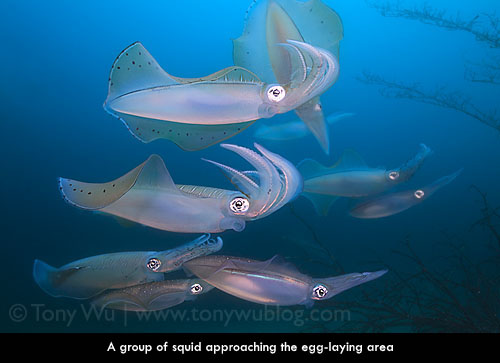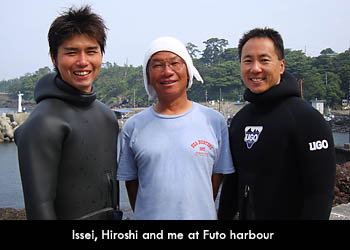Squid are fascinating.
Their bodies are generally slender and elongated; they have eight arms plus two tentacles; they can manipulate body colour and patterns via chromatophores; they squirt ink as a means of self-defence; they have large, inquisitive eyes; and most of all...they just look weird, like some fantastic figment of a child's hyperactive imagination.
In case you were wondering, there are something on the order of 300 known species of squid, ranging from the relatively small ones divers come across in shallow waters to gigantic deep-dwelling species that probably spawned age-old legends of vicious man-eating krakens.
A couple of weeks ago, I travelled to the Izu Peninsula in Japan to spend some quality time with one particular type of squid...bigfin reef squid (Sepioteuthis lessoniana), known as アオリイカ (aori-ika) in Japanese.

Thinking About Sex
To clarify one thing right upfront...I usually don't go to the trouble of taking a trip just to see relatively common squid, but this trip is something I've been wanting to do for a while.
You see...each spring and summer throughout the waters of the Izu Peninsula, bigfin reef squid gather in large numbers for courtship, mating and egg-laying. The diving community in Japan has documented this phenomenon for many years, so there's plenty of information available (in Japanese of course) on this annual event.
When the water warms up to around 19ºC or so, which usually happens some time around late May to early June, the squid come inshore and into the shallows to do their thing. For whatever reason, the water didn't warm last year, and there was very little squid mating (at least in the areas that divers frequent), so my friends in Izu were understandably anxious about how this season's major squid social event would develop.
As it turned out, the warming of local waters took place suddenly, shortly after my earlier visit to Izu in April...which meant squid mating started early this year, with lots and lots of squid.
So it was that I made my way back to Izu, with the sole ambition of being a squid-sex voyeur.

My Peeping Tom Experience
All told, I stayed a week in Izu, but due to a convergence of foul weather, sudden fever and equipment problems, I was only able to spend a few dives observing the squid. Despite the seemingly bad luck, I was actually quite fortunate.
I got sick on the days with the worst weather, so I didn't really miss much. My equipment flubbed up on the days with the worst light and water conditions, so again, I didn't lose out.
And on the three dives when I had optimal conditions (clear water, cooperative cephalopods, no other divers flailing about and chasing squid away)...my new Canon 5D Mark II worked perfectly and I was completely alert. Plus, I had learned a lot from observing the squid during my earlier dives when I wasn't able to get any photographs...so by the time all the starfish finally aligned, I was able to nail the shots I wanted.
Here's a rundown of what I observed and learned:
- In preparation for mating, the squid gather in large groups, usually near or above a site they've collectively decided to use for depositing eggs. How they decide on a specific site is beyond me, but it's common practice for the local fishermen and dive operations to sink a few clumps of tree branches in relatively shallow water (say 15 to 20 metres) just before squid mating season. This provides the squid with convenient nurseries, and divers with predictable access to the squid.
In the two locations where I dived with squid, the trees of choice were Castanopsis cuspidata (in Futo harbour) and bamboo (at Hatsushima). As far as I can tell, there's no particular reason for the selecting these trees, besides local availability.

- The squid appear to engage in much of the courtship, male-to-male aggression, etc. in mid-water, relatively high up in the water column. Once a male and female have paired up, they mate in mid-water and then descend to the egg-laying area together.
- The male protects the female all the time. If another male approaches, the original male becomes visibly agitated and flashes warning colours, communicating obvious irritation. If the intruder persists, both males extend their swimming fins and flare out their legs and tentacles...basically engaging in a visual pissing match. Occasionally, more than two males go at each other...leading to a twisted turmoil of tangled teuthid tentacles.

- Occasionally, the males make physical contact, but it seemed as if the original male usually wins without having to resort to 10-limbed fisticuffs, and the male/ female continue toward the bottom. Once they reach the egg-laying site, the males stands guard over the female while she deposits a bunch of eggs. Though it's tempting to interpret this as an act of cephalopodic chivalry, it's probably just the male ensuring that the eggs he fertilised are placed in a safe location without interference.
- One particular amazing talent I saw is the ability of the males to flash "Stay the heck away!" colouration on the half of their bodies facing a potential competitor(s), while simultaneously maintaining a soothing "I love you" white tone on the side of their bodies facing the females (proving beyond a shadow of a doubt that males of all species, even invertebrates, can multi-task).

- Even though they pair up, the squid seem to move in groups. Mated pairs approached egg-laying locations in waves, and then retreated more-or-less all at the same time. Perhaps they behaved this way in order to have some semblance of safety in numbers. This would make sense, given the abundance of moray eels hidden among the tree branches, ready at a moment's notice to grab a savoury squid snack, as well as the many brown-lined puffers (Canthigaster rivulata) milling about, darting in to take a small bite out of any squid that wasn't paying attention.
- The time during which females are busy laying eggs seemed to be prime time for male squid to challenge one another, often with the relevant female appearing to be oblivious to the mad waving of tentacles and angry displays of colour going on behind her. On a few occasions, it seemed as if a female I was watching departed the site with a different male than she'd arrived with (...women...sigh). I couldn't be completely certain, so that's something I'll have to watch out for next time.
- There are apparently two major mating cycles, with the first running from May to late June/ early July, followed by a hiatus during which there's little or no mating, and then another round of mating in August/ September. I apparently caught the tail-end of the first round, as most of the squid disappeared a few days after I left. The second round doesn't always take place, so it'll be interesting to see what happens in a month or two.

- There seems to be some measure of local variation from site to site. For instance, between the two sites I visited (Futo and Hatsushima), the squid at Hatsushima were slightly bigger (perhaps 10-15cm longer for the largest males) and seemingly less cautious around me (though that might have been due to fewer divers being around). There seemed to even be some differences in the squid populations at different tree branch clusters in the same general area. The squid I encountered at the Yoko-iso dive site in Futo were less wary of me than the ones at the Yoko-bama site.
I'm tempted to speculate that each unique sub-population/ sub-aggregation of mating squids develops a temporary group dynamic that determines their sub-population's behaviour and characteristics, but it would take much more time and methodical observation to establish whether that's actually the case or not.

- After the squid finish mating, they die, which provides a feast for the moray eels and other scavenger/ predators in the area. This is similar to the "mate and die" reproductive strategy followed by other marine animals, such as salmon and octopuses. The squid don't just mate once though. As soon as the female lays her eggs, she's off to mate again. I'm not sure how long this continues, but it goes on for a while.
- Finally, although it's definitely possible to get close to the squid, it takes time and patience. On my first dive with the squid, another group of divers approached after I'd spent 25 minutes waiting for the squid to get comfortable with me. Just as the nervous cephalopods had accepted me, the other divers rushed in...finning madly, blowing bubbles, snapping away with cameras and mis-aimed strobes. And, of course...the squid vanished into thin water, as any self-respecting cephalopod would do when confronted by a gaggle of stark-raving lunatics.
Wrapping Up
As always, I owe a debt of gratitude to my friends in Izu who educated me about the squid and helped arrange the logistics of getting to the right places at the right times.
Specifically, Satoshi and Issei took great care of me while I was in Futo, and Shinohara-san escorted me for my first visit to Hatsushima.
 Also, one thing that's unique to Japan is the close relationship between the fishing and diving communities. There are positive aspects to this symbiosis, as well as some challenges, but in short, having the support and cooperation of the fishing community is essential.
Also, one thing that's unique to Japan is the close relationship between the fishing and diving communities. There are positive aspects to this symbiosis, as well as some challenges, but in short, having the support and cooperation of the fishing community is essential.
I was fortunate to have the help of Hiroshi-san, who took us out on his fishing boat to the Yoko-iso dive site in Futo. This was critical, as it got me to a relatively isolated school of squid, where I was able to spend all the time I needed to watch, learn and photograph. Thanks Hiroshi-san!
If there's one regret I have about this experience, it's that I didn't have video gear with me. There was so much action and drama, and the squid are so expressive...that there were many times I found myself wishing I had been prepared with video equipment.
Circumstances permitting, I'll head back again next year to give it another go.